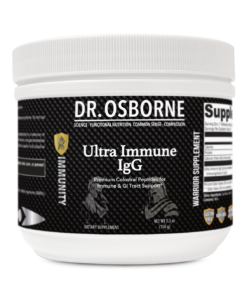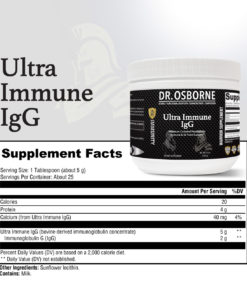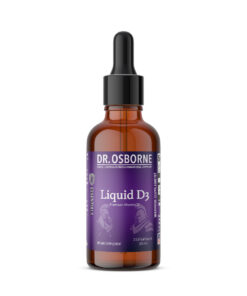Ultra Immune IgG Powder – Subscription
From: $59.95 every 3 months
UltraImmune IgG
Immunoglobulin Concentrate From Colostral Whey Peptides
Suggested Use
Mix one tablespoon (about 5g) into 2-4 oz of water and consume daily, or take as directed by your healthcare practitioner.
DOES NOT CONTAIN
Wheat, gluten, yeast, soy, animal or dairy products, fish, shellfish, peanuts, tree nuts, egg, ingredients derived from genetically modified organisms (GMOs), artificial colors, artificial sweeteners, or artificial preservatives.
Clinical Applications
Supports Immune Function by Providing Immunoglobulins and Other Immune Factors*
Supports the Body’s Normal Gut Repair Pathways*
Helps Maintain a Healthy Microbial and Cytokine Balance in the Gut*
Promotes Overall Health and Well-Being*
UltraImmune IgG is an immunoglobulin concentrate derived from colostral whey peptides. It delivers natural immunoglobulins (standardized to a minimum of 40% IgG), bioactive proteins, and growth factors. These components support immune function, healthy cytokine activity, gut barrier function, and gastrointestinal health and tissue repair. Advanced coagulation and filtration techniques make UltraImmune IgG a unique, GRAS formula that is superior in its bioactive composition and its purity.*
Discussion
Beyond Colostrum: Immunoglobulin Concentrate from Colostral Whey Peptides
UltraImmune IgG is the result of advanced coagulation and filtration technologies that separate bioactive substances and then concentrate them. These precise systems produce a potent, pure, and generally recognized as safe (GRAS) immunoglobulin concentrate from colostral whey peptides. UltraImmune IgG provides immunoglobulins, including a minimum of 40% IgG; bioactive and growth factors; oligosaccharides; and gangliosides. Each of these components provides the user with different and complementary health benefits.1
Immunoglobulins
Oral consumption of immunoglobulins derived from colostrum is a means of supporting passive immunity.[2-5] Immunoglobulins flag antigens for the immune system. In doing so, immunoglobulins become key participants in protecting the body and eliminating unwanted molecules. UltraImmune IgG delivers immunoglobulins and is particularly high (minimum of 40%) in IgG. Among immunoglobulins, IgG is said to be the most versatile, carrying out all of the functions of immunoglobulin molecules.*
Bioactive and Growth Factors
Sialic acid is an essential component of mucins, glycoproteins, oligosaccharides, and gangliosides and is therefore important to the function of cell membranes and membrane receptors. It is also important for normal brain development. Sialic acid containing oligosaccharides in bovine colostrum can prevent certain antigens from binding to host tissues. Lactoferrin is an immune-supporting, iron-binding glycoprotein naturally found in bovine colostrum. It plays an important role in immune regulation and in the body’s defense mechanisms.[6] Studies suggest that growth factors from bovine colostrum, including IGF-1 (insulin-like growth factor) and TGF (transforming growth factor), stimulate cell growth in the gut to strengthen the gut lining, help build lean muscle mass, and slow protein catabolism.[1] Furthermore, improvements observed in exercise performance by athletes taking colostrum have been attributed to growth factors.*
Proline-Rich Peptides
Proline-rich peptides (PRPs), which were first isolated from ovine colostrum and later from bovine colostrum, are intercellular signaling molecules. They act as regulatory Clinical Applications substances that have the unique ability to modulate and stabilize various biologic processes in the body, such as cytokine and immune processes.[1] The in vitro and in vivo effects of PRPs on immunoregulation, including their effects on the maturation and differentiation of thymocytes and humoral and cellular immune responses, have been demonstrated. Also of great interest are the many studies suggesting their beneficial effects on age-associated changes in neurological health.[7] For instance, in vivo work revealed that PRPs alleviate beta-amyloid cytotoxicity in hippocampal neuronal cells; in humans, PRPs provided an early beneficial effect on cognitive symptoms and daily functioning at a dose as low as 100 mcg/d every other day.[8,9] Five grams of powder or eight capsules of UltraImmune IgG provides 1% to 2% (50 to 100 mg) PRPs.*
Oligosaccharides
Bovine milk oligosaccharides, which are a component of lactose, are modulators of gut microbiota. They provide protection by acting as decoys to attract antigens and inhibit them from binding to epithelial surfaces of the intestine.[10] Evidence also suggests that oligosaccharides act as growth promoters for a selected class of beneficial bacteria[11] and contribute to the development and maturation of the intestinal immune response.[12] Approximately 66 acidic and neutral oligosaccharides, including sialyloligosaccharides, which are known for their high biological activity in humans, have been detected in IgG concentrate from colostral whey peptides.*[13]
Gangliosides
Gangliosides are vital to the structure and function of cell membranes. They support neural development, and they have roles in supporting gut integrity, influencing immune cell signaling, modulating cytokine activity and production, and affecting the adherence and toxin production of antigens.[14-17] Research has demonstrated that providing gangliosides in the diet increases ganglioside content in the intestinal mucosa. Studies have indicated that low levels of gangliosides in the intestinal mucosa are associated with increased levels of cytokines, susceptibility to antigens, and poor gut integrity.[14] The ganglioside composition of bovine milk is predominately GM3 and GD3.*[15]
*These statements have not been evaluated by the FDA. This product is not intended to diagnose, treat, cure or prevent any disease.
References
- Godhia M, et al. Curr Res Nutr Food Sci. 2013;1(1):37-47. http://dx.doi. org/10.12944/CRNFSJ.1.1.04
- Hurley D. [Dissertation]. Brookings, SD: South Dakota State University; 1994.
- Hurley WL, et al. Nutrients. 2011 Apr;3(4):442-74. [PMID: 22254105]
- Rump JA, et al. Clin Investig. 1992 Jul;70(7):588-94. [PMID: 1392428]
- Schaller JP, et al. J Infect Dis. 1992 Apr;165(4):623-30. [PMID: 1313067]
- Berlutti F, et al. Molecules. 2011 Aug 16;16(8):6992-7018. [PMID: 21847071]
- Janusz M, et al. Cell Mol Biol (Noisy-le-grand). 2013 Nov 3;59(1):4-11. [PMID: 24200016]
- Froud KE, et al. J Alzheimers Dis. 2010;20(2):423-26. [PMID: 20164569]
- Bilikiewicz A, et al. J Alzheimers Dis. 2004 Feb;6(1):17-26. [PMID: 15004324]
- Lane JA, et al. Int J Food Microbiol. 2012 Jul 2;157(2):182-8. [PMID: 22647676]
- Aldredge DL, et al. Glycobiology. 2013 Jun;23(6):664-76. [PMID: 23436288]
- Lane JA, et al. Br J Nutr. 2013 Dec;110(12):2127-37. [PMID: 23710626]
- Barile D. Milk oligosaccharides. Confidential Report. Brookings, SD: Sterling Technology; 2011. [on file]
- Miklavcic JJ, et al. J Nutr Metab. 2012;2012:280286. [PMID: 22506104]
- Lee H, et al. J Agric Food Chem. 2013 Oct 9;61(40):9689-96. [PMID: 24024650]
- Sánchez-Juanes F, et al. Biol Chem. 2009 Jan;390(1):31-40. [PMID: 18937626]
- Park EJ, et al. J Pediatr Gastroenterol Nutr. 2010 Mar;50(3):321-28. [PMID: 20118807]









Reviews
There are no reviews yet.